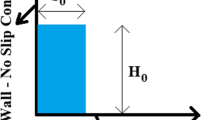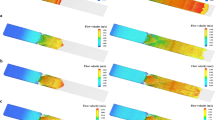Abstract
A new numerical scheme based on the finite-element method with a total-variation-diminishing property is developed with the aim of studying the shock-capturing capability of the combination. The proposed model is formulated within the framework of the one-step Taylor–Galerkin scheme in conjunction with the Van Leer’s limiter function. The approach is applied to the two-dimensional shallow water equations by different test cases, i.e., the partial, circular, and one-dimensional dam-break flow problems. For the one-dimensional case, the sub- and supercritical flow regimes are considered. The results are compared with the analytical, finite-difference, and smoothed particle hydrodynamics solutions in the literature. The findings show that the proposed model can effectively mask the sources of errors in the abrupt changes of the flow conditions and is able to resolve the shock and rarefaction waves where other numerical models produce spurious oscillations.










Similar content being viewed by others
Abbreviations
- B(r):
-
Van Leer’s limiter
- d :
-
Constant coefficient
- F :
-
Flux vectors’ matrix
- g :
-
Gravity
- G :
-
Flux vectors’ matrix
- h :
-
Water depth
- h e :
-
Element size
- h L :
-
Water depth in the upstream channel
- h R :
-
Water depth in the downstream channel
- h i :
-
Numerical depth results in each node
- i :
-
Node number
- K :
-
Stiffness matrix
- L :
-
Length of the computational domain
- M :
-
Mass matrix
- n :
-
Manning’s roughness coefficient
- S :
-
Topographical and frictional source terms
- S bx :
-
Depth gradients in the x-directions
- S by :
-
Depth gradients in the y-directions
- S fx :
-
Friction slopes along x-directions
- S fy :
-
Friction slopes along y-directions
- s :
-
Bore speed
- t :
-
Time
- U :
-
Matrix of variables
- u :
-
Depth-integrated velocity in the x-directions
- v :
-
Depth-integrated velocity in the y-directions
- x :
-
x-direction space
- y :
-
y-direction space
- \(\varPsi_{i}\) :
-
Basis-function
References
Lauritzen PH (2011) Numerical techniques for global atmospheric models. In: Lecture notes in computational science and engineering, vol 73. Springer, Berlin, p 572
Akkerman I et al (2011) Isogeometric analysis of free-surface flow. J Comput Phys 230:4137–4152
Ouyang C, He S, Xu Q (2014) MacCormack-TVD finite difference solution for dam break hydraulics over erodible sediment beds. J Hydraul Eng 141:06014026
Luo Z, Gao J (2015) The numerical simulations based on the NND finite difference scheme for shallow water wave equations including sediment concentration. Comput Methods Appl Mech Eng 294:245–258
Amini R, Maghsoodi R, Moghaddam N (2016) Simulating free surface problem using isogeometric analysis. J Braz Soc Mech Sci Eng 38:413–421
Wang P, Zhang N (2014) A large-scale wave-current coupled module with wave diffraction effect on unstructured meshes. Sci China Phys Mech Astron 57:1331–1342
Zhang M-L et al (2016) Numerical simulation of flow and bed morphology in the case of dam break floods with vegetation effect. J Hydrodyn Ser B 28:23–32
Triki A (2013) A finite element solution of the unidimensional shallow-water equation. J Appl Mech 80:021001
Ortiz P (2014) Shallow water flows over flooding areas by a flux-corrected finite element method. J Hydraul Res 52:241–252
Isakson MJ, Chotiros NP, Piper J (2015) Finite element modeling of propagation and reverberation shallow water waveguide with a variable environment. J Acoust Soc Am 138:1898
Yin J, Sun J-W, Jiao Z-F (2015) A TVD-WAF-based hybrid finite volume and finite difference scheme for nonlinearly dispersive wave equations. Water Sci Eng 8:239–247
Crespo A, Gómez-Gesteira M, Dalrymple R (2008) Modeling dam break behavior over a wet bed by a sph technique. J Waterw Port Coast Ocean Eng 134:313–320
Chang T-J et al (2011) Numerical simulation of shallow-water dam break flows in open channels using smoothed particle hydrodynamics. J Hydrol 408:78–90
Zhang M et al (2014) Integrating 1D and 2D hydrodynamic, sediment transport model for dam-break flow using finite volume method. Sci China Phys Mech Astron 57:774–783
Zarmehi F, Tavakoli A, Rahimpour M (2011) On numerical stabilization in the solution of Saint-Venant equations using the finite element method. Comput Math Appl 62:1957–1968
Atallah MH, Hazzab A (2013) A Petrov–Galerkin scheme for modeling 1D channel flow with varying width and topography. Acta Mech 224:707–725
Wang H-H et al (1972) Numerical solutions of the one-dimensional primitive equations using Galerkin approximations with localized basis functions. Mon Weather Rev 100:738–746
Sheu TWH, Fang CC (2001) High resolution finite-element analysis of shallow water equations in two dimensions. Comput Methods Appl Mech Eng 190:2581–2601
Harten A (1983) High resolution schemes for hyperbolic conservation laws. J Comput Phys 49:357–393
Wang J, Ni H, He Y (2000) Finite-difference TVD scheme for computation of dam-break problems. J Hydraul Eng 126:253–262
Boulahia A, Abboudi S, Belkhiri M (2014) Simulation of viscous and reactive hypersonic flows behaviour in a shock tube facility: TVD schemes and flux limiters application. J Appl Fluid Mech 7:315–328
Ouyang C et al (2013) A MacCormack-TVD finite difference method to simulate the mass flow in mountainous terrain with variable computational domain. Comput Geosci 52:1–10
Huang Z, Lee J-J (2014) Modeling the spatial evolution of roll waves with diffusive Saint Venant equations. J Hydraul Eng 141:06014022
Vacondio R, Dal Palù A, Mignosa P (2014) GPU-enhanced finite volume shallow water solver for fast flood simulations. Environ Model Softw 57:60–75
Stoker JJ (1992) Water waves; the mathematical theory with applications. Pure and applied mathematics. Interscience Publishers, New York
Zachariah C (2000) A characteristics finite-element algorithm for computational open channel flow analysis. The University of Tennessee, Knoxville
Selmin V (1987) Finite element solution of hyperbolic equations II. Two dimensional case. Inria, Paris
Yee H, Warming R, Harten A (1983) Implicit total variation diminishing (TVD) schemes for steady-state calculations. In: 6th computational fluid dynamics conference danvers. American Institute of Aeronautics and Astronautics
Toro EF (2001) Shock-capturing methods for free-surface shallow flows, vol xv. Wiley, Chichester, p 309
Zienkiewicz OC, Taylor RL (eds) (2000) The finite element method. Butterworth-Heinemann, Oxford
Falconer RA (1986) Water quality simulation study of a natural harbor. J Waterw Port Coast Ocean Eng 112:15–34
Ransom O, Younis B (2015) Selective application of a total variation diminishing term to an implicit method for two-dimensional flow modelling. J Flood Risk Manag 8:52–61
Alcrudo F, Garcia-Navarro P (1993) A high-resolution Godunov-type scheme in finite volumes for the 2D shallow-water equations. Int J Numer Meth Fluids 16:489–505
Ying X, Wang S, Khan A (2003) Numerical simulation of flood inundation due to dam and levee breach. In: World water and environmental resources congress. American Society of Civil Engineers, pp 1–9
Liang S-J, Tang J-H, Wu M-S (2008) Solution of shallow-water equations using least-squares finite-element method. Acta Mech Sinica 24:523–532
Chou C et al (2015) Extrapolated local radial basis function collocation method for shallow water problems. Eng Anal Bound Elem 50:275–290
Neumann P, Bungartz H-J (2015) Dynamically adaptive Lattice Boltzmann simulation of shallow water flows with the Peano framework. Appl Math Comput 267:795–804
Touma R, Klingenberg C (2015) Well-balanced central finite volume methods for the Ripa system. Appl Numer Math 97:42–68
Author information
Authors and Affiliations
Corresponding author
Additional information
Technical Editor: Jader Barbosa Jr.
Rights and permissions
About this article
Cite this article
Seyedashraf, O., Akhtari, A.A. Two-dimensional numerical modeling of dam-break flow using a new TVD finite-element scheme. J Braz. Soc. Mech. Sci. Eng. 39, 4393–4401 (2017). https://doi.org/10.1007/s40430-017-0776-y
Received:
Accepted:
Published:
Issue Date:
DOI: https://doi.org/10.1007/s40430-017-0776-y




